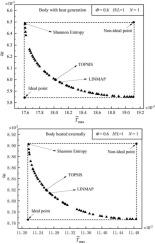最大温差和熵产率最小的叉形空腔多目标结构设计
IF 5.4
3区 工程技术
Q2 ENERGY & FUELS
引用次数: 0
摘要
基于最大温差(MTD)最小化的叉形空腔模型的结构设计。本文对其进行了进一步的研究。首先,对考虑熵产率(EGR)最小化的矩形实体墙进行了产热和外加热情况下的结构设计,并与考虑MTD最小化的结果进行了比较。以叉形空腔长径比(H0/L0)为设计变量,研究了矩形实体壁长径比(H/L)、叉形空腔孔隙率(Φ)和叉形空腔分支数(N)对结构设计的影响。其次,通过最小化EGR和MTD的线性加权和的复合函数进行结构设计。第三,基于NSGA-II进行多目标结构设计,对比三种决策方法的偏差指标,确定设计方案。当Φ=0.6, H/L=1, N=1时,两种情况下,考虑EGR最小化的最优H0/L0分别为0.79和0.61,考虑MTD最小化的最优H0/L0分别为0.7和0.664;与初始设计相比,复合功能分别降低了21.06%和1.29%;在Pareto边界上得到的最优H0/L0分别在0.7-0.79和0.61-0.664之间,TOPSIS决策方法的结果偏差指数最小,被选为最佳折衷设计方案。本文的主要贡献是将EGR最小化目标引入到不同条件下叉形空腔的结构设计中,并采用加权和函数、NSGA-II和三种决策方法实现了空腔的moo。本文章由计算机程序翻译,如有差异,请以英文原文为准。

Multi-objective constructal designs for fork-shaped cavities with minimizing maximum-temperature-difference and entropy-generation-rate
Constructal design for a fork-shaped cavity model with maximum-temperature-difference (MTD) minimization was performed previously. Herein, it is studied furtherly. Firstly, constructal designs considering entropy-generation-rate (EGR) minimization are performed under cases of rectangular solid wall with heat-generation and heated externally, and are compared with results considering MTD minimization. Aspect ratio () of fork-shaped cavity is taken as design variable, and influences of aspect ratio () of rectangular solid wall, porosity () of fork-shaped cavity and number () of branches of fork-shaped cavity on constructal designs are studied. Secondly, constructal designs are performed by minimizing a composite-function of linear weighting-sum of EGR and MTD. Thirdly, multi-objective constructal designs are performed based on NSGA-II, and deviation indexes with three decision-making methods are compared to determine design schemes. When , and , under two cases, optimal considering EGR minimization are 0.79 and 0.61 respectively, while optimal considering MTD minimization are 0.7 and 0.664 respectively; composite functions are decreased by 21.06% and 1.29% compared to their initial designs respectively; optimal gained in Pareto frontiers are located between 0.7–0.79 and 0.61–0.664 respectively, and results of TOPSIS decision-making method have the smallest deviation indexes, and are selected as the best compromise design schemes. The major contribution herein are introducing EGR minimization objective into constructal-design for fork-shaped cavities with different conditions, and realizing MOOs for cavities with weighting-sum function, NSGA-II and three decision-making methods.
求助全文
通过发布文献求助,成功后即可免费获取论文全文。
去求助
来源期刊

Thermal Science and Engineering Progress
Chemical Engineering-Fluid Flow and Transfer Processes
CiteScore
7.20
自引率
10.40%
发文量
327
审稿时长
41 days
期刊介绍:
Thermal Science and Engineering Progress (TSEP) publishes original, high-quality research articles that span activities ranging from fundamental scientific research and discussion of the more controversial thermodynamic theories, to developments in thermal engineering that are in many instances examples of the way scientists and engineers are addressing the challenges facing a growing population – smart cities and global warming – maximising thermodynamic efficiencies and minimising all heat losses. It is intended that these will be of current relevance and interest to industry, academia and other practitioners. It is evident that many specialised journals in thermal and, to some extent, in fluid disciplines tend to focus on topics that can be classified as fundamental in nature, or are ‘applied’ and near-market. Thermal Science and Engineering Progress will bridge the gap between these two areas, allowing authors to make an easy choice, should they or a journal editor feel that their papers are ‘out of scope’ when considering other journals. The range of topics covered by Thermal Science and Engineering Progress addresses the rapid rate of development being made in thermal transfer processes as they affect traditional fields, and important growth in the topical research areas of aerospace, thermal biological and medical systems, electronics and nano-technologies, renewable energy systems, food production (including agriculture), and the need to minimise man-made thermal impacts on climate change. Review articles on appropriate topics for TSEP are encouraged, although until TSEP is fully established, these will be limited in number. Before submitting such articles, please contact one of the Editors, or a member of the Editorial Advisory Board with an outline of your proposal and your expertise in the area of your review.
 求助内容:
求助内容: 应助结果提醒方式:
应助结果提醒方式:


